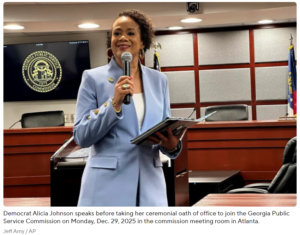TENNESSEE: Black Pastors, Confederate Descendants Share Civil War History in Tennessee Town
FRANKLIN, Tenn. — African-American pastors recently touring a restored Confederate plantation here stopped to look at the rocks in the grass near a path between the ivory obelisks commemorating the land’s white owners and a gated cemetery of granite headstones for Confederate soldiers.
A new sign described the rocks as grave markers for buried slaves: “The only marked graves in the African-American section are those of Mariah and Bolen Reddick’s sons who were stillborn in 1877.”
The pastors said little during the tour of the Carnton Plantation on the Battlefield of Franklin.
“I was taken by the uncomeliness of my ancestors’” graves, Pastor Chris Williamson of the Strong Tower Bible Church in Nashville said later. “That would’ve been my family. I would’ve been buried right there.”
Being by the graves felt sacred, he added.
Franklin and other towns across the South are finding small ways to acknowledge the unheralded battles of African-Americans to survive slavery and live free.
White nationalist and pro-Nazi activity in Charlottesville, Virginia and elsewhere last year prompted the removal of Confederate statues in some large cities. But in most Southern towns, state laws and continuing white support for the Confederate memorials make such dramatic action illegal and highly unpopular.
The fate of Franklin’s Confederate statue, which sits in the center of town in front of the old courthouse, is not up for debate. The Tennessee Heritage Protection act of 2013 prohibits its removal. Some 70 Confederate statues dot Tennessee, which lost 64,333 Confederate soldiers during the war.
Memphis, 200 miles away, found a loophole in the law that allowed officials to remove the statues of Confederate President Jefferson Davis and Gen. Nathan Bedford Forrest in 2017. State lawmakers retaliated a year later, cutting the city’s budget by $250,000.
No one here wants to fight over the statue, for fear of a violent backlash and the time and money it would cost in legal and other expenses, Williamson said.
“You pick your battles,” said Williamson. “It doesn’t make me angry…. I hope our city is much more than a Civil War soldier.”
The new sign next to the rock gravestones represents a larger effort by community members to tell the history of the Civil War beyond just what happened to the Confederate soldiers and slave owners. There are other plans to add to the history, but they are wrapped in secrecy until those leading the effort are satisfied they have garnered enough support from local leaders, Capital News Service learned during a recent visit.
Meanwhile, the statue of a common soldier with a rifle at rest stands on the grounds of a former slave market. It commemorates one of the bloodiest Confederate battlefield defeats. Fondly known as “Chip” because of an accidental chip in the hat, it was erected in 1899, 35 years after the battle, during the segregationist Jim Crow era.
Many residents interviewed say the statue is a benign historical symbol — or that they don’t pay attention to it at all.
Hewitt Sawyers, Pastor elder at West Harpeth Primitive Baptist Church, said he notices the statue every day when he enters the city.
“I have looked at (the statue) since I was a boy coming into the city of Franklin and I always had a little empty spot in my stomach,” said Sawyers. “… It was kind of like I was being watched. I needed to be on my best behavior because that guy was watching me, that statue was watching me, every time that I came around.”
Sawyers, who also took the plantation tour, said, “I never did think there was a way he could be taken down so I never did pursue anything like that.”
PICKING BATTLES
Twenty miles from Nashville, Franklin is a time-capsule of a bygone era.
“If you drive around Franklin … you would get the impression that the South won the war,” said Kevin Riggs of Franklin Community Church, as he drove visitors past a memorial to the Army of Tennessee engraved with the names of Confederate generals.
With a population of 75,000, it is an up-and-coming city with a town square of small shops and trendy restaurants. It’s a popular tourist destination, especially for those interested in Confederate history.
Franklin is 86 percent white and 6 percent black. Recent arrivals come for jobs in corporate management, finance, insurance and technology.
Alma McLemore, president of the African-American Heritage Society in Franklin, has been working to educate visitors on the black history of the town, especially at the McLemore house, which was built by a former slave and is now a museum under construction.
“People need to know who did all the work and who built these homes and who took care of the children and who did so much to sustain the lives of the people during that time,” she said.
PASTOR TOUR
The Franklin Battlefield Trust, which manages and preserves the Carnton Plantation and Carter House, both sites of the Battle of Franklin, is taking the initiative to tell a fuller story of the Civil War.
Eric Jacobson, CEO of the Trust, included signs marking the slave graves.
“The truth of the matter is if Eric wasn’t a part of this process, this movement that’s happening, we wouldn’t be able to be heard the way we’ve been heard,” Williamson said. “His white skin gives him the ability to go further with the information than if it was just me saying it. He’s key to the whole thing.”
Jacobson also led the pastors’ tour. Williamson said some participants were wary at first because previous tours ignored the slave graves and the slave houses.
Riggs, of Franklin Community Church, said he went through a dramatic transformation recently after learning more about slavery. In school, he said, he learned slavery was wrong, but that “their owners treated them really, really well. They were very, very good slave owners.”
After more self-study, “I became more of an advocate.” he said, “As a white person, (I asked), what can I do, what can I say, to help influence things?”
INTERTWINING LIVES TODAY
More than 50 years after the end of segregation, descendants of slaves and descendants of the people who owned their ancestors, live side-by-side here.
One white resident, Jenny Peach, discovered recently that she and her son are close friends with the descendants of the slaves her family once owned.
“This family, they are like the most amazing wonderful people I’ve ever met in my entire life,” she said.
Before Peach told her son, Landon, and his best friend, Brandon, both 10, about their connection, she walked into her son’s room and saw them playing a video game.
“They’re just playing and they had no idea what happened 150 years ago to their ancestors,” she said.
Kristina Farrow, a staff genealogist at the Carnton Plantation, tells an uglier side of Franklin’s history. Using census data from 1859-1860, she discovered that 18 enslaved mothers in the district of Williamson County where Franklin is located, smothered their babies. She believes, the killings were meant to save the infants from a life of slavery, although it is impossible to know for certain. No white babies in the county were smothered, she said.
“Within the institution of slavery, humanity cannot exist, and that’s another thing we try to understand from a 21st century perspective,” she said.
On the porch of the McLemore house one recent afternoon, Farrow and Billy McLemore were sitting as they do every Saturday. Harvey Chrisman walked up and joined them.
Like McLemore, Chrisman’s ancestors were also slaves in Franklin. He is proud to be their descendent, but recent events have changed the tenor of relations in town, he said.
When he sees new Confederate symbols today, he said, he tries to look away.
“There was a time when you would barely see a Confederate flag,” he said. “Now you see them all along with cars and trucks.”
Chrisman knows it’s difficult to change people’s minds.
“You’re not gonna tell them (the Confederate supporters) it’s all about slavery,” he said. “They all jump up and down and said it wasn’t. Progress was being made but the stigma is back within the past year.”
Still, Jacobson, Riggs, McLemore and Chrisman remain hopeful the story of black people during the Civil War will be told and someday be accepted as the mainstream narrative.
“Black history is seen as something separate from American history,” Williamson said. But the “truth that was crushed to earth is rising again.”



